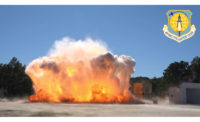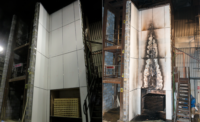

Structural designers say there is cause for concern but no reason to panic over research that indicates potential for premature failure of flat-plate concrete frames reinforced at slab-column connections with a popular shear-studs-on-a-rail detail.
Engineers estimate that in seismic zones alone there are tens of millions of sq ft of flat-plate systems reinforced using shear studs. The extent of their vulnerability to punching shear failure is still unknown.
The research has made “the profession take pause,” says Randall W. Poston, principal of WDP & Associates PC, Austin, and chair of the American Concrete Institute's structural concrete building code committee. The group is responsible for developing the ACI 318 Building Code.
The use of shear studs has become mainstream for reinforcing against punching shear in flat slabs, regardless of the seismic hazard of the building site, say engineers. “Existing buildings [with this system] may present an even a bigger issue than new construction,” says Poston.
The main problem is the orthogonal shear-stud layout, which is published in ACI 318, says Gustavo J. Parra-Montesinos, a professor of civil engineering at the University of Michigan, Ann Arbor, and the researcher who is raising the red flag about the poor performance of the popular detail. The detail leaves areas around the columns completely unreinforced for shear, he says.
The layout allows slab cracking to form off the column corners, which can cause premature failure, adds Cary Kopczynski of the Bellevue, Wash., structural firm that bears his name. The studs are smooth and consequently do not bond to the concrete. As a result, large diagonal shear cracks form, resulting in loss of aggregate interlock at high load levels, he says. Also, the bottom rail appears insufficient to anchor and develop the studs as intended, Kopczynski says.
But though engineers register concern and support further study, they do not think there is an immediate threat to public safety. The majority of existing concrete buildings with shear studs in regions of high seismicity will likely perform satisfactorily in a design-level earthquake, says Kopczynski. Most buildings have sufficient stiffness to control the earthquake induced horizontal displacements that can lead to punching shear problems.
ACI 318 also requires structural engineers to provide bottom rebar over columns, post-tensioning cables directly over columns or both, says the engineer. These are also intended to prevent punching shear failures from occurring.
Kopczynski nevertheless thinks there are buildings with slab shear-stud reinforcing and flexible seismic systems that will undergo significant lateral movements in large earthquakes. Though these buildings likely met the requirements of the building code they were designed to, the recent research is clearly a red flag that problems may be present, he says.
Parra's orthogonal test specimens were designed according to Section 11.11.5 of the ACI 318-11, which first appeared in 2008. It states: “Headed shear stud reinforcement, placed perpendicular to the plane of a slab or a footing, shall be permitted in slabs and footings….”
The orthogonal configuration is popular because it lines up with the reinforcing steel and is consequently relatively easy to construct. “The benefits in construction speed and popularity for maximizing usable space from floor to ceiling have made [flat-plate shear-studs] the system of choice over other building frame and wall systems,” says Poston. There is less labor for installation—and at the same time reducing congestion in the slab-column connection region, he adds.
Parra says the layout issue is not specific to frames in seismic zones. Gravity-load tests produced premature failure as well. “There can be punching shear failures without earthquakes,” he says.
Concern About Code
The engineer has a related concern about the ACI code. “The code allows you to design for higher shear stresses if you use shear studs as compared to any other type of shear reinforcement,” he says. “I don't think that is justified.”
His advice: “If you are using shear studs, consider using more uniformly spaced studs around the column, such as in a radial, not orthogonal, layout.”
Parra first discovered the premature failure problem by accident in 2007, during National Science Foundation-funded physical testing of fiber-reinforced concrete systems. “We wanted to show that our solution for fiber reinforcement would perform as well as accepted practice with shear studs so we tested a shear-stud specimen under seismic loads as a control,” says Parra. “We got surprised by a very early failure.”
The test was performed at the Minneapolis-based Multi-Axial Subassemblage Testing laboratory (MAST), under a grant from NSF's Network for Earthquake Engineering Simulation (NEES). Carol K. Shield, director of MAST, says: “The specimen couldn't hold the gravity load during reasonably small displacements of the column. The code would tell you it should have been able to hold the gravity load for a larger column displacement.”
Parra and his team have performed subsequent tests of the detail, under seismic and gravity loads, also at MAST. All have confirmed the initial findings.
The team is currently performing additional tests on a radial layout of the shear studs, in which the studs emanate from the faces and corners of the columns. The performance is greatly improved, says Parra. But the problem is that a radial layout is not as constructible as an orthogonal layout.
Testing Refined Layouts
In a subsequent test, scheduled for November at MAST and funded by a $162,000 grant from the Charles Pankow Foundation, Parra will be evaluating refined radial shear stud layouts, in an effort to develop standard designs that will show good ductility and deformation capacity during earthquakes and will also be economical to construct. Recently, the team tested a radial layout that did perform better than the cruciform layout, but Parra thinks the specimen can be further refined to perform well without complicating design.
Both Poston and Parra think that after the tests are concluded, a survey of existing buildings that contain the orthogonal shear-stud layout might be in order, to determine whether there is a need for remediation in any of the structures. “The most important thing is to take care of whatever is dangerous,” says Parra.
If he gets funding, the next round of research would be to develop a retrofit detail. Parra expects to submit a proposal by November for NEES funding.




Post a comment to this article
Report Abusive Comment